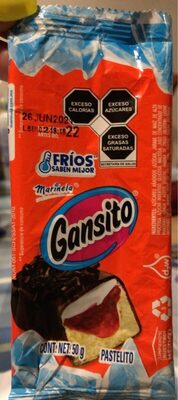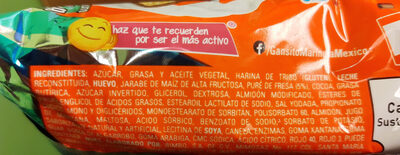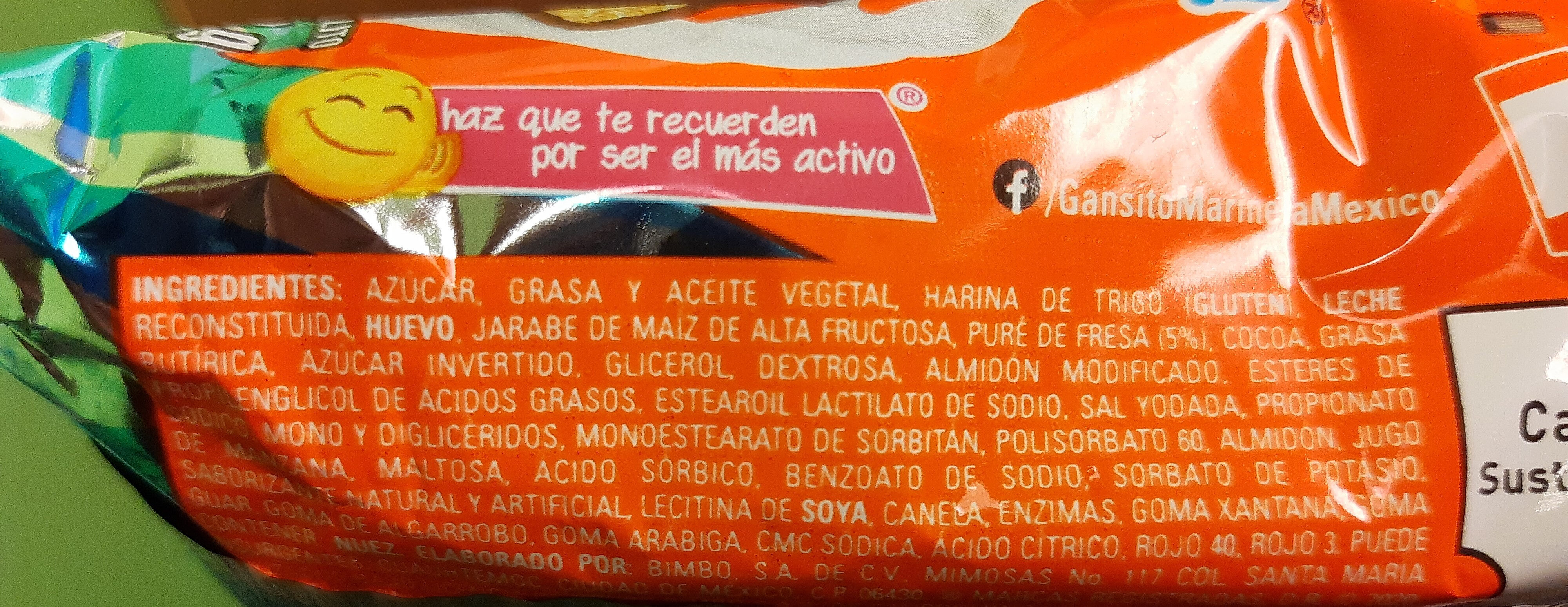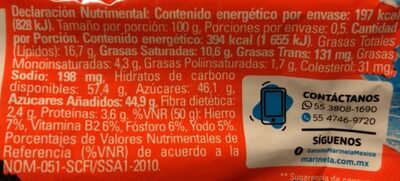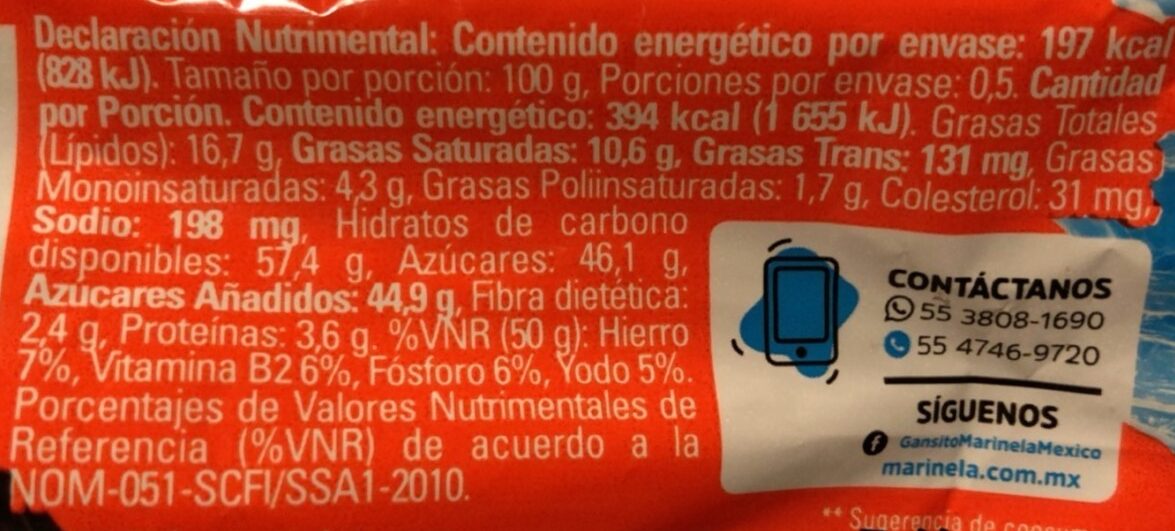Ajuda'ns a fer que la transparència alimentària sigui la norma!
Com a organització sense ànim de lucre, depenem de les vostres donacions per continuar informant els consumidors de tot el món sobre tot allò què mengen.
La revolució alimentària comença amb tu!
Gansito - Marinela - 50 g
Gansito - Marinela - 50 g
Aquesta pàgina del producte no està completa. Podeu ajudar a completar-la editant-la i afegint-hi més dades a partir de les fotos ja disponibles, o fent-ne més amb l'aplicació de androide o iPhone / iPad. Gràcies!
×
Codi de barres: 7501000153107 (EAN / EAN-13)
Quantitat: 50 g
Empaquetament: en:aluminum foil
Marques: Marinela
Categories: Snacks, Aperitius dolços, Galetes i pastissos, Pastís, Pastisseria
Països on es va vendre: Mèxic
Matching with your preferences
Salut
Ingredients
-
38 ingredients
Castellà: AZUCAR, GRASA Y ACEITE VEGETAL, HARINA DE TRIGO GLUTEN LECHE RECONSTITUIDA, HUEVO, JARABE DE MAIZ DE ALTA FRUCTOSA, PURĖ DE FRESA (5%), COCOA, GRASA DUTIRICA, AZUCAR INVERTI00. GLICEROL, DEXTROSA, ALMIDON MODIFICADO. ESTERES DE ROP ENGLICOL DE ACIDOS GRASOS, ESTEAROIL LACTILATO DE SODIO, SAL YOOADA, PROPIONATO MONO Y DIGLICERIDOS, MONOESTEARATO DE SORBITAN, POLISORBATO 60, ALMIDON. JUGD DE MAANA MALTOSA, ACIDO SORBICO, BENZOATO 0E SODIO, SORBATO DE POTASIO. SABORIZA TE NATURAL Y ARTIFICIAL, LECITINA DE SOYA, CANELA, ENZIMAS, GOMA XANTANA OMA GUAR GOMA DE ALGARROB0, GOMA ARABIGA, CMC SODICA, ACIDO CITRICO, ROJO 40, ROJO 3 PUEDE CONTENER NUEZ ELABORADO POR: BIMBO, SA. DE CV. MIMOSAS No 117 COL SANTA MARIA Ca Sust LSURGENT S CUAL HTEMOC CUDAD DE MEXICO CP 06430 MARCA S REGAl·lèrgens: en:Eggs, en:Soybeans
Processament d'aliments
-
Aliments ultra processats
Elements que indiquen que el producte està al grup 4 - Aliments i begudes ultraprocessats:
- Additiu: E129 - Vermell Allure 2C
- Additiu: E14XX - Midó modificat
- Additiu: E322 - Lecitines
- Additiu: E414 - Goma aràbiga
- Additiu: E415 - Goma de xantè
- Additiu: E422 - Glicerol
- Additiu: E435 - Monoestearat de sorbitan polioxietilenat
- Additiu: E466 - Carboximetilcellulosa sòdica
- Additiu: E481 - Estearoïl-2-lactilat de sodi
- Ingredient: Dextrosa
- Ingredient: Glucosa
- Ingredient: Xarop de blat de moro alt en fructosa
Els productes alimentaris es classifiquen en 4 grups segons el seu grau de processament:
- Aliments no processats o mínimament processats
- Ingredients culinaris processats
- Aliments processats
- Aliments ultra processats
La determinació del grup es fa en funció de la categoria del producte i dels ingredients que conté.
Additius
-
E129 - Vermell Allure 2C
Allura Red AC: Allura Red AC is a red azo dye that goes by several names, including FD&C Red 40. It is used as a food dye and has the E number E129. It is usually supplied as its red sodium salt, but can also be used as the calcium and potassium salts. These salts are soluble in water. In solution, its maximum absorbance lies at about 504 nm.Origen: Wikipedia (Anglès)
-
E200 - Àcid sòrbic
Sorbic acid: Sorbic acid, or 2‚4-hexadienoic acid, is a natural organic compound used as a food preservative. It has the chemical formula CH3-CH-4CO2H. It is a colourless solid that is slightly soluble in water and sublimes readily. It was first isolated from the unripe berries of the Sorbus aucuparia -rowan tree-, hence its name.Origen: Wikipedia (Anglès)
-
E202 - Sorbat de potassi
Potassium sorbate: Potassium sorbate is the potassium salt of sorbic acid, chemical formula CH3CH=CH−CH=CH−CO2K. It is a white salt that is very soluble in water -58.2% at 20 °C-. It is primarily used as a food preservative -E number 202-. Potassium sorbate is effective in a variety of applications including food, wine, and personal-care products. While sorbic acid is naturally occurring in some berries, virtually all of the world's production of sorbic acid, from which potassium sorbate is derived, is manufactured synthetically.Origen: Wikipedia (Anglès)
-
E322 - Lecitines
Lecithin: Lecithin -UK: , US: , from the Greek lekithos, "egg yolk"- is a generic term to designate any group of yellow-brownish fatty substances occurring in animal and plant tissues, which are amphiphilic – they attract both water and fatty substances -and so are both hydrophilic and lipophilic-, and are used for smoothing food textures, dissolving powders -emulsifying-, homogenizing liquid mixtures, and repelling sticking materials.Lecithins are mixtures of glycerophospholipids including phosphatidylcholine, phosphatidylethanolamine, phosphatidylinositol, phosphatidylserine, and phosphatidic acid.Lecithin was first isolated in 1845 by the French chemist and pharmacist Theodore Gobley. In 1850, he named the phosphatidylcholine lécithine. Gobley originally isolated lecithin from egg yolk—λέκιθος lekithos is "egg yolk" in Ancient Greek—and established the complete chemical formula of phosphatidylcholine in 1874; in between, he had demonstrated the presence of lecithin in a variety of biological matters, including venous blood, in human lungs, bile, human brain tissue, fish eggs, fish roe, and chicken and sheep brain. Lecithin can easily be extracted chemically using solvents such as hexane, ethanol, acetone, petroleum ether, benzene, etc., or extraction can be done mechanically. It is usually available from sources such as soybeans, eggs, milk, marine sources, rapeseed, cottonseed, and sunflower. It has low solubility in water, but is an excellent emulsifier. In aqueous solution, its phospholipids can form either liposomes, bilayer sheets, micelles, or lamellar structures, depending on hydration and temperature. This results in a type of surfactant that usually is classified as amphipathic. Lecithin is sold as a food additive and dietary supplement. In cooking, it is sometimes used as an emulsifier and to prevent sticking, for example in nonstick cooking spray.Origen: Wikipedia (Anglès)
-
E322i - Lecitina
Lecithin: Lecithin -UK: , US: , from the Greek lekithos, "egg yolk"- is a generic term to designate any group of yellow-brownish fatty substances occurring in animal and plant tissues, which are amphiphilic – they attract both water and fatty substances -and so are both hydrophilic and lipophilic-, and are used for smoothing food textures, dissolving powders -emulsifying-, homogenizing liquid mixtures, and repelling sticking materials.Lecithins are mixtures of glycerophospholipids including phosphatidylcholine, phosphatidylethanolamine, phosphatidylinositol, phosphatidylserine, and phosphatidic acid.Lecithin was first isolated in 1845 by the French chemist and pharmacist Theodore Gobley. In 1850, he named the phosphatidylcholine lécithine. Gobley originally isolated lecithin from egg yolk—λέκιθος lekithos is "egg yolk" in Ancient Greek—and established the complete chemical formula of phosphatidylcholine in 1874; in between, he had demonstrated the presence of lecithin in a variety of biological matters, including venous blood, in human lungs, bile, human brain tissue, fish eggs, fish roe, and chicken and sheep brain. Lecithin can easily be extracted chemically using solvents such as hexane, ethanol, acetone, petroleum ether, benzene, etc., or extraction can be done mechanically. It is usually available from sources such as soybeans, eggs, milk, marine sources, rapeseed, cottonseed, and sunflower. It has low solubility in water, but is an excellent emulsifier. In aqueous solution, its phospholipids can form either liposomes, bilayer sheets, micelles, or lamellar structures, depending on hydration and temperature. This results in a type of surfactant that usually is classified as amphipathic. Lecithin is sold as a food additive and dietary supplement. In cooking, it is sometimes used as an emulsifier and to prevent sticking, for example in nonstick cooking spray.Origen: Wikipedia (Anglès)
-
E330 - Acid citric
Citric acid: Citric acid is a weak organic acid that has the chemical formula C6H8O7. It occurs naturally in citrus fruits. In biochemistry, it is an intermediate in the citric acid cycle, which occurs in the metabolism of all aerobic organisms. More than a million tons of citric acid are manufactured every year. It is used widely as an acidifier, as a flavoring and chelating agent.A citrate is a derivative of citric acid; that is, the salts, esters, and the polyatomic anion found in solution. An example of the former, a salt is trisodium citrate; an ester is triethyl citrate. When part of a salt, the formula of the citrate ion is written as C6H5O3−7 or C3H5O-COO-3−3.Origen: Wikipedia (Anglès)
-
E414 - Goma aràbiga
Gum arabic: Gum arabic, also known as acacia gum, arabic gum, gum acacia, acacia, Senegal gum and Indian gum, and by other names, is a natural gum consisting of the hardened sap of various species of the acacia tree. Originally, gum arabic was collected from Acacia nilotica which was called the "gum arabic tree"; in the present day, gum arabic is collected from acacia species, predominantly Acacia senegal and Vachellia -Acacia- seyal; the term "gum arabic" does not indicate a particular botanical source. In a few cases so‐called "gum arabic" may not even have been collected from Acacia species, but may originate from Combretum, Albizia or some other genus. Producers harvest the gum commercially from wild trees, mostly in Sudan -80%- and throughout the Sahel, from Senegal to Somalia—though it is historically cultivated in Arabia and West Asia. Gum arabic is a complex mixture of glycoproteins and polysaccharides. It is the original source of the sugars arabinose and ribose, both of which were first discovered and isolated from it, and are named after it. Gum arabic is soluble in water. It is edible, and used primarily in the food industry as a stabilizer, with EU E number E414. Gum arabic is a key ingredient in traditional lithography and is used in printing, paint production, glue, cosmetics and various industrial applications, including viscosity control in inks and in textile industries, though less expensive materials compete with it for many of these roles. While gum arabic is now produced throughout the African Sahel, it is still harvested and used in the Middle East.Origen: Wikipedia (Anglès)
-
E415 - Goma de xantè
Xanthan gum: Xanthan gum -- is a polysaccharide with many industrial uses, including as a common food additive. It is an effective thickening agent and stabilizer to prevent ingredients from separating. It can be produced from simple sugars using a fermentation process, and derives its name from the species of bacteria used, Xanthomonas campestris.Origen: Wikipedia (Anglès)
-
E422 - Glicerol
Glycerol: Glycerol -; also called glycerine or glycerin; see spelling differences- is a simple polyol compound. It is a colorless, odorless, viscous liquid that is sweet-tasting and non-toxic. The glycerol backbone is found in all lipids known as triglycerides. It is widely used in the food industry as a sweetener and humectant and in pharmaceutical formulations. Glycerol has three hydroxyl groups that are responsible for its solubility in water and its hygroscopic nature.Origen: Wikipedia (Anglès)
-
E466 - Carboximetilcellulosa sòdica
Carboxymethyl cellulose: Carboxymethyl cellulose -CMC- or cellulose gum or tylose powder is a cellulose derivative with carboxymethyl groups --CH2-COOH- bound to some of the hydroxyl groups of the glucopyranose monomers that make up the cellulose backbone. It is often used as its sodium salt, sodium carboxymethyl cellulose.Origen: Wikipedia (Anglès)
-
E481 - Estearoïl-2-lactilat de sodi
Sodium stearoyl lactylate: Sodium stearoyl-2-lactylate -sodium stearoyl lactylate or SSL- is a versatile, FDA approved food additive used to improve the mix tolerance and volume of processed foods. It is one type of a commercially available lactylate. SSL is non-toxic, biodegradable, and typically manufactured using biorenewable feedstocks. Because SSL is a safe and highly effective food additive, it is used in a wide variety of products ranging from baked goods and desserts to pet foods.As described by the Food Chemicals Codex 7th edition, SSL is a cream-colored powder or brittle solid. SSL is currently manufactured by the esterification of stearic acid with lactic acid and partially neutralized with either food-grade soda ash -sodium carbonate- or caustic soda -concentrated sodium hydroxide-. Commercial grade SSL is a mixture of sodium salts of stearoyl lactylic acids and minor proportions of other sodium salts of related acids. The HLB for SSL is 10-12. SSL is slightly hygroscopic, soluble in ethanol and in hot oil or fat, and dispersible in warm water. These properties are the reason that SSL is an excellent emulsifier for fat-in-water emulsions and can also function as a humectant.Origen: Wikipedia (Anglès)
Anàlisi dels ingredients
-
Pot contenir oli de palma
Ingredients que poden contenir oli de palma: Greix, Oli vegetal, E481
-
No és vegà
Ingredients no vegans: OuAlguns ingredients no s'han pogut reconèixer.
Necessitem la teva ajuda!
Podeu ajudar-nos a reconèixer més ingredients i analitzar millor la llista d'ingredients d'aquest producte i d'altres mitjançant:
- Editeu aquesta pàgina de producte per corregir les faltes d’ortografia de la llista d’ingredients i/o per eliminar els ingredients d’altres idiomes i frases que no estiguin relacionades amb els ingredients.
- Afegiu entrades, sinònims o traduccions noves a les nostres llistes multilingües d’ingredients, mètodes de processament d’ingredients i etiquetes.
Uniu-vos al canal #ingredients del nostre espai de discussió a Slack i/o apreneu sobre l'anàlisi dels ingredients en la nostra wiki, si voleu ajudar. Gràcies!
-
Es desconeix si és vegetarià
Ingredients no reconeguts: es:harina-de-trigo-gluten-leche-reconstituida, es:purė-de-fresa, es:grasa-dutirica, es:azucar-inverti00, es:esteres-de-rop-englicol-de-acidos-grasos, es:sal-yooada, es:propionato-mono-y-digliceridos, es:monoestearato-de-sorbitan, es:jugd-de-maana-maltosa, es:benzoato-0e-sodio, es:saboriza-te-natural-y-artificial, es:goma-xantana-oma-guar-goma-de-algarrob0, es:por, es:bimbo, es:sa, es:de-cv, es:mimosas-no-117-col-santa-maria-ca-sust-lsurgent-s-cual-htemoc-cudad-de-mexico-cp-06430-marca-s-regAlguns ingredients no s'han pogut reconèixer.
Necessitem la teva ajuda!
Podeu ajudar-nos a reconèixer més ingredients i analitzar millor la llista d'ingredients d'aquest producte i d'altres mitjançant:
- Editeu aquesta pàgina de producte per corregir les faltes d’ortografia de la llista d’ingredients i/o per eliminar els ingredients d’altres idiomes i frases que no estiguin relacionades amb els ingredients.
- Afegiu entrades, sinònims o traduccions noves a les nostres llistes multilingües d’ingredients, mètodes de processament d’ingredients i etiquetes.
Uniu-vos al canal #ingredients del nostre espai de discussió a Slack i/o apreneu sobre l'anàlisi dels ingredients en la nostra wiki, si voleu ajudar. Gràcies!
-
Detalls de l'anàlisi dels ingredients
Necessitem la teva ajuda!
Alguns ingredients no s'han pogut reconèixer.
Necessitem la teva ajuda!
Podeu ajudar-nos a reconèixer més ingredients i analitzar millor la llista d'ingredients d'aquest producte i d'altres mitjançant:
- Editeu aquesta pàgina de producte per corregir les faltes d’ortografia de la llista d’ingredients i/o per eliminar els ingredients d’altres idiomes i frases que no estiguin relacionades amb els ingredients.
- Afegiu entrades, sinònims o traduccions noves a les nostres llistes multilingües d’ingredients, mètodes de processament d’ingredients i etiquetes.
Uniu-vos al canal #ingredients del nostre espai de discussió a Slack i/o apreneu sobre l'anàlisi dels ingredients en la nostra wiki, si voleu ajudar. Gràcies!
es: AZUCAR, GRASA, ACEITE VEGETAL, HARINA DE TRIGO GLUTEN LECHE RECONSTITUIDA, HUEVO, JARABE DE MAIZ DE ALTA FRUCTOSA, PURĖ DE FRESA 5%, COCOA, GRASA DUTIRICA, AZUCAR INVERTI00, GLICEROL, DEXTROSA, ALMIDON MODIFICADO, ESTERES DE ROP ENGLICOL DE ACIDOS GRASOS, ESTEAROIL LACTILATO DE SODIO, SAL YOOADA, PROPIONATO mono- y DIGLICERIDOS, MONOESTEARATO DE SORBITAN, POLISORBATO 60, ALMIDON, JUGD DE MAANA MALTOSA, ACIDO SORBICO, BENZOATO 0E SODIO, SORBATO DE POTASIO, SABORIZA TE NATURAL y ARTIFICIAL, LECITINA DE SOYA, CANELA, ENZIMAS, GOMA XANTANA OMA GUAR GOMA DE ALGARROB0, GOMA ARABIGA, CMC SODICA, ACIDO CITRICO, ROJO 40, POR (BIMBO), SA, DE CV, MIMOSAS No 117 COL SANTA MARIA Ca Sust LSURGENT S CUAL HTEMOC CUDAD DE MEXICO CP 06430 MARCA S REG- AZUCAR -> en:sugar - vegan: yes - vegetarian: yes - ciqual_proxy_food_code: 31016 - percent_min: 5 - percent_max: 70
- GRASA -> en:fat - vegan: maybe - vegetarian: maybe - from_palm_oil: maybe - percent_min: 5 - percent_max: 37.5
- ACEITE VEGETAL -> en:vegetable-oil - vegan: yes - vegetarian: yes - from_palm_oil: maybe - percent_min: 5 - percent_max: 26.6666666666667
- HARINA DE TRIGO GLUTEN LECHE RECONSTITUIDA -> es:harina-de-trigo-gluten-leche-reconstituida - percent_min: 5 - percent_max: 21.25
- HUEVO -> en:egg - vegan: no - vegetarian: yes - ciqual_food_code: 22000 - percent_min: 5 - percent_max: 18
- JARABE DE MAIZ DE ALTA FRUCTOSA -> en:high-fructose-corn-syrup - vegan: yes - vegetarian: yes - ciqual_food_code: 31077 - percent_min: 5 - percent_max: 15.8333333333333
- PURĖ DE FRESA -> es:purė-de-fresa - percent_min: 5 - percent: 5 - percent_max: 5
- COCOA -> en:cocoa - vegan: yes - vegetarian: yes - ciqual_proxy_food_code: 18100 - percent_min: 0 - percent_max: 5
- GRASA DUTIRICA -> es:grasa-dutirica - percent_min: 0 - percent_max: 5
- AZUCAR INVERTI00 -> es:azucar-inverti00 - percent_min: 0 - percent_max: 5
- GLICEROL -> en:e422 - vegan: maybe - vegetarian: maybe - percent_min: 0 - percent_max: 5
- DEXTROSA -> en:dextrose - vegan: yes - vegetarian: yes - ciqual_proxy_food_code: 31016 - percent_min: 0 - percent_max: 5
- ALMIDON MODIFICADO -> en:modified-starch - vegan: yes - vegetarian: yes - ciqual_proxy_food_code: 9510 - percent_min: 0 - percent_max: 5
- ESTERES DE ROP ENGLICOL DE ACIDOS GRASOS -> es:esteres-de-rop-englicol-de-acidos-grasos - percent_min: 0 - percent_max: 5
- ESTEAROIL LACTILATO DE SODIO -> en:e481 - vegan: maybe - vegetarian: maybe - from_palm_oil: maybe - percent_min: 0 - percent_max: 5
- SAL YOOADA -> es:sal-yooada - percent_min: 0 - percent_max: 5
- PROPIONATO mono- y DIGLICERIDOS -> es:propionato-mono-y-digliceridos - percent_min: 0 - percent_max: 4.66666666666667
- MONOESTEARATO DE SORBITAN -> es:monoestearato-de-sorbitan - percent_min: 0 - percent_max: 4.375
- POLISORBATO 60 -> en:e435 - vegan: maybe - vegetarian: maybe - percent_min: 0 - percent_max: 4.11764705882353
- ALMIDON -> en:starch - vegan: yes - vegetarian: yes - ciqual_proxy_food_code: 9510 - percent_min: 0 - percent_max: 3.88888888888889
- JUGD DE MAANA MALTOSA -> es:jugd-de-maana-maltosa - percent_min: 0 - percent_max: 3.68421052631579
- ACIDO SORBICO -> en:e200 - vegan: yes - vegetarian: yes - percent_min: 0 - percent_max: 3.5
- BENZOATO 0E SODIO -> es:benzoato-0e-sodio - percent_min: 0 - percent_max: 3.33333333333333
- SORBATO DE POTASIO -> en:e202 - vegan: yes - vegetarian: yes - percent_min: 0 - percent_max: 3.18181818181818
- SABORIZA TE NATURAL y ARTIFICIAL -> es:saboriza-te-natural-y-artificial - percent_min: 0 - percent_max: 3.04347826086957
- LECITINA DE SOYA -> en:soya-lecithin - vegan: yes - vegetarian: yes - ciqual_food_code: 42200 - percent_min: 0 - percent_max: 2.91666666666667
- CANELA -> en:cinnamon - vegan: yes - vegetarian: yes - percent_min: 0 - percent_max: 2.8
- ENZIMAS -> en:enzyme - vegan: maybe - vegetarian: maybe - percent_min: 0 - percent_max: 2.69230769230769
- GOMA XANTANA OMA GUAR GOMA DE ALGARROB0 -> es:goma-xantana-oma-guar-goma-de-algarrob0 - percent_min: 0 - percent_max: 2.59259259259259
- GOMA ARABIGA -> en:e414 - vegan: yes - vegetarian: yes - percent_min: 0 - percent_max: 2.5
- CMC SODICA -> en:e466 - vegan: yes - vegetarian: yes - percent_min: 0 - percent_max: 2.41379310344828
- ACIDO CITRICO -> en:e330 - vegan: yes - vegetarian: yes - percent_min: 0 - percent_max: 2.33333333333333
- ROJO 40 -> en:e129 - vegan: yes - vegetarian: yes - percent_min: 0 - percent_max: 2.25806451612903
- POR -> es:por - percent_min: 0 - percent_max: 2.1875
- BIMBO -> es:bimbo - percent_min: 0 - percent_max: 2.1875
- SA -> es:sa - percent_min: 0 - percent_max: 2.12121212121212
- DE CV -> es:de-cv - percent_min: 0 - percent_max: 2.05882352941176
- MIMOSAS No 117 COL SANTA MARIA Ca Sust LSURGENT S CUAL HTEMOC CUDAD DE MEXICO CP 06430 MARCA S REG -> es:mimosas-no-117-col-santa-maria-ca-sust-lsurgent-s-cual-htemoc-cudad-de-mexico-cp-06430-marca-s-reg - percent_min: 0 - percent_max: 2
Nutrició
-
Mala qualitat nutricional
⚠ ️Atenció: la quantitat de fruita, verdura i fruits secs no s'especifica a l'etiqueta, s'ha fet una estimació a partir de la llista d'ingredients: 0Aquest producte no es considera una beguda per al càlcul de la Nutri-Score.
Punts positius: 2
- Proteïnes: 2 / 5 (valor: 3.6, valor arrodonit: 3.6)
- Fibra: 2 / 5 (valor: 2.4, valor arrodonit: 2.4)
- Fruites, verdures, fruits secs i olis de colza/nou/oliva: 0 / 5 (valor: 0, valor arrodonit: 0)
Punts negatius: 25
- Energia: 4 / 10 (valor: 1648, valor arrodonit: 1648)
- Sucres: 9 / 10 (valor: 44.9, valor arrodonit: 44.9)
- Greixos saturats: 10 / 10 (valor: 10.6, valor arrodonit: 10.6)
- Sodi: 2 / 10 (valor: 198, valor arrodonit: 198)
Els punts per proteïnes no es compten perquè els punts negatius són més o iguals a 11.
Puntuació nutricional: (25 - 2)
Nutri-Score:
-
Nivells de nutrients
-
Greix en Quantitat moderada (16.7%)
Què us cal saber- Un alt consum de greixos, especialment de greixos saturats, pot augmentar el colesterol, que augmenta el risc de patir malalties del cor.
Recomanació: Reduïu el consum de greixos i greixos saturats- Trieu productes amb menys greixos i greixos saturats.
-
Àcid gras saturat en alta quantitat (10.6%)
Què us cal saber- Un alt consum de greixos, especialment de greixos saturats, pot augmentar el colesterol, que augmenta el risc de patir malalties del cor.
Recomanació: Reduïu el consum de greixos i greixos saturats- Trieu productes amb menys greixos i greixos saturats.
-
Sucre en alta quantitat (44.9%)
Què us cal saber- Un alt consum de sucre pot provocar augment de pes i càries dental. També augmenta el risc de patir diabetis tipus 2 i malalties cardiovasculars.
Recomanació: Limitau el consum de sucre i de begudes ensucrades- Les begudes ensucrades (com ara refrescos, begudes de fruites i sucs i nèctars de fruites) s'han de limitar tant com sigui possible (no més d'1 got al dia).
- Triau productes amb menor contingut de sucre i reduïu el consum de productes amb sucres afegits.
-
Sal comuna en Quantitat moderada (0.495%)
Què us cal saber- Un alt consum de sal (o sodi) pot provocar un augment de la pressió arterial, que pot augmentar el risc de patir malalties del cor i ictus.
- Moltes persones que tenen hipertensió no ho saben, ja que sovint no en tenen símptomes.
- La majoria de la gent consumeix massa sal (de 9 a 12 grams de mitjana al dia), al voltant del doble del nivell màxim d'ingesta recomanat.
Recomanació: Limitau la ingesta de sal i d'aliments rics en sal- Reduïu la sal que emprau quan cuinau, i no afegiu sal a taula.
- Limiteu el consum d'aperitius salats i trieu productes amb menor contingut de sal.
-
-
Informació nutricional
Informació nutricional Com es ven
per 100 g/100 mlCom es ven
per porció (50g)Comparat amb: Pastisseria Energia 1.648 kj
(394 kcal)824 kj
(197 kcal)-1% Greix 16,7 g 8,35 g -10% Àcid gras saturat 10,6 g 5,3 g +41% Hidrats de carboni 46,1 g 23,1 g -10% Sucre 44,9 g 22,4 g +91% Fiber 2,4 g 1,2 g +14% Proteïna 3,6 g 1,8 g -35% Sal comuna 0,495 g 0,247 g -9% Alcohol 0 % vol 0 % vol Fruits‚ vegetables‚ nuts and rapeseed‚ walnut and olive oils (estimate from ingredients list analysis) 0 % 0 %
Entorn
-
Puntuació ecològica no calculada - Impacte ambiental desconegut
No hem pogut calcular l'Eco-Score d'aquest producte perquè li falten algunes dades, podríeu ajudar-nos a completar-lo?Podries afegir una categoria del producte més precisa perquè puguem calcular l'Eco-Score? Afegir una categoria
Empaquetament
-
Embalatge de baix impacte
-
Peces d'embalatge
Film
-
Materials d'embalatge
Material % Pes de l'embalatge Pes de l'embalatge per 100 g de producte
-
Transport
-
Orígens dels ingredients
Falta informació sobre l'origen dels ingredients
⚠ ️ L'origen dels ingredients d'aquest producte no està indicat.
Si estan indicats a l'embalatge, podeu modificar la fitxa del producte i afegir-los.
Si sou el fabricant d'aquest producte, podeu enviar-nos la informació amb la nostra plataforma gratuïta per a productors.Add the origins of ingredients for this product Add the origins of ingredients for this product
Report a problem
-
Incomplete or incorrect information?
Category, labels, ingredients, allergens, nutritional information, photos etc.
If the information does not match the information on the packaging, please complete or correct it. Open Food Facts is a collaborative database, and every contribution is useful for all.
Fonts de dades
Producte afegit per org-app-elcoco
Última modificació de la pàgina del producte per roboto-app.
La pàgina del producte, també editada per acuario, chevalstar, elitzia, kiliweb, openfoodfacts-contributors, packbot, scanbot, segundo, veganeamos, yuka.sY2b0xO6T85zoF3NwEKvlnxGQvyOr274DALTiFKSndGSJ43oQv51-IzzH6s.
